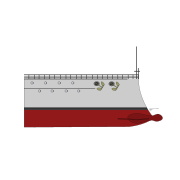Bow (watercraft)

The bow ⫽baʊ⫽ is the forward part of the hull of a ship or boat, the point that is usually most forward when the vessel is underway. Both of the adjectives fore and forward mean towards the bow. The other end of the boat is the stern.
Etymology
From Middle Dutch boech or Old Norse bógr (shoulder).
Function

The bow is designed to reduce the resistance of the hull cutting through water and should be tall enough to prevent water from easily washing over the top of it. On slower ships like tankers, a fuller bow shape is used to maximise the volume of the ship for a given length.
A "wet bow" results from seawater washing over the top of the hull. A raked stem can help to reduce the wetness of the bow. Aside from making the deck slippery, water can corrode the metal of the ship. If the temperature is low enough this water can also freeze on the deck, rails, turrets, and other exposed surfaces, increasing the topside weight.
The bow may be reinforced to serve as an ice-breaker, one example being the bow of container-ship Sea Witch whose reinforcement was the cause of significant damage to another ship in a 1973 collision.
Parts
The forward part of the bow, usually on the ship's centreline, is called the stem. Traditionally, the stem was an upright timber or metal bar into which side planks or plates were joined.
Types
Several types of bows exist. These include:
-
clipper bow
-
curved bow
-
plumb bow
-
raked bow
-
High-chin spoon bow
-
Low-chin spoon bow
-
Straight bow (Direct angle close to 90 degr.)
See also
- Aft
- Boat building
- Bow (rowing)
- Deck
- Figurehead
- Naval architecture
- Port
- Prow
- Shipbuilding
- Starboard
- Stem (ship)
- Superstructure
References
Further reading
- Sleight, Steve; The New Complete Sailing Manual, Dorling Kindersley Co., (2005) ISBN 0-7566-0944-5
- Steward, Robert; Boatbuilding Manual, 3rd ed. International Marine Publishing Company. Camden, Maine (1987), p2-3. ISBN 0-87742-236-2










